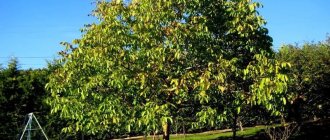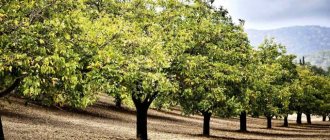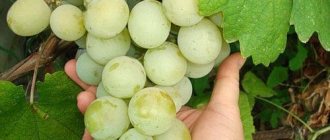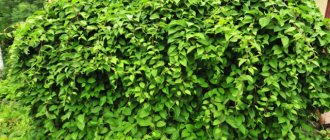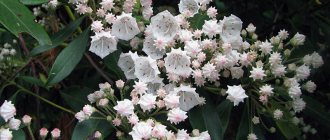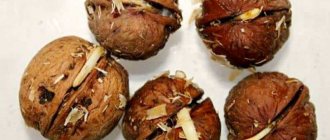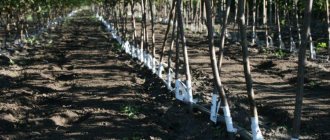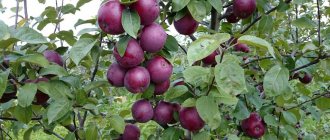Selection of fruit and variety
The process of growing a plant directly depends on the quality of planting material. The fruit must be fresh. Do not use nuts that have been dried or heat treated. It is worth considering that old nuts germinate much worse.
Therefore, you need to buy fruits for planting in September. You shouldn’t buy store-bought nuts because you can’t be sure of their freshness and lack of processing. The ideal solution would be nuts that were collected yourself.
It is important that the fruit is ripe. It should not have stains or damaged areas. The shell should be quite thin. To grow a crop from a fruit, it is necessary to select the largest specimens.
Before planting, you should try the nuts from the collected batch. They must have excellent taste. When choosing a variety, you should give preference to those that grow in this area.
Variety selection
For central Russia, varieties such as Pelan, Urozhainy, Marion, Zarya Vostoka, Duet, Aurora, Velikan, and Zarya Vostoka are suitable.
Preparing nuts before planting
Before planting, the fruits should be prepared. To do this, they are exposed to cold, water, and ultraviolet light. If the plant is planned to be planted in the spring, it is necessary to perform stratification.
To do this, the fruits should be immersed in a container with wet sand, and then taken to a place with a low temperature - 0-+5 degrees. This could be a basement or a refrigerator.
Stratification will take 3-4 months. Every 3-4 weeks, nuts should be removed and ventilated. At this point, it is recommended to moisten the sand. After stratification, the nut is placed back into the soil.
Also, before spring planting, the fruits can be placed for 1 month in a room with a temperature of less than +10 degrees. Then soak in a container of water at room temperature and leave for 2-5 days.
It is worth considering that only those fruits that have sunk to the bottom can be used for planting. Nuts remaining on the surface can be discarded.
After the specified time, only those fruits are removed from the container whose flaps have moved apart and a root has formed. To make it grow and become stronger, the nuts are placed in a container filled with wet sand or sawdust, after which it is taken out to a warm room. The temperature in it should be +25-28 degrees.
After 10 days, the roots will grow to 0.5-1 cm. When this happens, the containers are transferred to a cool place. They must be there until the crop is planted.
Both shelled and unshelled nuts are allowed to be grown. At the same time, the former exhibit faster germination. To clean the fruit, you should carefully remove the top shell. This must be done so as not to touch the inner layer.
It is worth considering that the manipulation should be carried out with gloves, otherwise the green layer will leave stains on the skin, which will be very difficult to get rid of.
If the inner shell is damaged, the nut will not be able to germinate or the sprout will become sick.
When planting in spring, nuts should be thoroughly dried. To do this, they are laid out horizontally in 1 layer and exposed to the sun for 2 days. Then the fruits are sent to a shaded place for 2-3 days. This will help dry them out. The use of special devices for drying is strictly prohibited.
If you plan to plant nuts at home in the fall, stratification is not required. Also, the fruits do not need to be germinated or dried.
Features of pruning young and old trees
When pruning young trees (up to 5 years old), pay attention to young green growth. There is a lot of it on the lower tier, which is why the branches are poorly lit. Remove the growth with garden shears - it is thin and does not require special tools. There is an opinion that when pruning, the walnut tree does not need to be lubricated with garden varnish - small wounds will heal on their own.
Attention! In the first years, special attention is paid to formative pruning. Despite the fact that the walnut is not yet bearing fruit, it is at this time that it is important to ensure that the branches grow in the right direction. Young plants should not be overcrowded.
Starting from 7-10 years old, a rejuvenating procedure is carried out annually. This is as important as timely watering or fertilizing. If the tree’s crown is not visible, then all non-fruit-bearing and deformed shoots are cut out. There is no need to be afraid of such drastic measures - this will rejuvenate the tree and extend its life. Gardeners make sure that branches do not grow inside the crown.
Selection of containers
Before growing a nut in central Russia, you need to choose the right container. To do this, you can take any deep pot that has good drainage. The first container should have a diameter and depth of about 25-30 cm. These are the parameters that will ensure freedom for the developing root system.
When grown in a pot, the crop is limited in growth. Therefore, seedlings 1-3 years old should be constantly replanted. It is recommended to do this once a year. It is recommended to choose a pot 8-9 cm larger than the previous one.
Post-procedure care
When the wounds heal, the walnut is sprayed with a solution of Bordeaux mixture or urea. This is done to protect the tree from diseases and pests. Treat the plant in the morning or evening, using a spray bottle with a solution.
Adult plants overwinter without shelter, and young trees are wrapped in burlap for the winter. The base of the trunk is mulched with hay or wood chips - this protects the root system from freezing. This rule is especially relevant for regions with cold and changeable climates.
How to grow at home?
To grow a plant from seeds, you need to follow certain recommendations.
After the sprout appears, the following conditions must be observed:
- At the initial stage, seedlings are grown in plastic cups. It is advisable to give preference to a container with a volume of 0.5 liters.
- The bottom of the cup needs to be pierced with a hot awl to create a hole. This will provide the necessary drainage and prevent the seeds from rotting due to the accumulation of excess moisture.
- Fill the container with garden soil. It is recommended to plant the nut to a depth of 5 cm. If necessary, more soil can be poured on top. After which the surface should be lightly pressed.
- Water the planting and move the container to the balcony. Seeds need light. However, direct sunlight is contraindicated for the plant.
- Seedlings should be watered sparingly. This should be done 3-4 times a week in small portions.
- When planting a crop in the fall in February, the glasses need to be moved into the house and placed on the windowsill.
Usually, after moving seedlings indoors, they sprout within 2-3 weeks. When the seedling reaches 10 cm, it can be transplanted into a pot. Typically, containers with a capacity of 1.5-2 liters are used.
Subsequent care of the crop remains the same. In early April, when the temperature outside the window increases, the plant should be returned to the balcony.
This will help you adapt to new conditions and prepare for planting in open ground. This manipulation should be carried out in May, when the earth and air are well warmed up. By this time the seedlings will have grown to 15-20 cm.
Caring for seedlings at home
To get a powerful and viable plant, during the period of caring for walnuts you need to follow these recommendations:
- Culture needs excellent lighting. If a seedling is constantly in the shade, it can get sick and even die. Moreover, this will happen in the active growth phase.
- The plant needs systematic hydration. The nut should be watered constantly to avoid drying out the earthen coma. It is worth considering that the crop tolerates drought worse than excess moisture. However, it is also not recommended to try too hard. Otherwise, there is a risk of root rotting.
- In warm weather, the container with the plant should be taken out into fresh air. However, it is important to ensure that the seedling is not exposed to drafts. In hot weather, the container with the nut should be wrapped in a damp cloth. This will help avoid overheating of the root system. At high temperatures, the pot can be lowered into cool water.
- The soil under the plant should be mulched. For this, peat, moss, and rotted organic fertilizers are used. If necessary, the mulch should be updated.
- The nut needs to be fertilized with fertilizer. It should contain a lot of potassium. The procedure should be carried out every 2 weeks. The manipulation is carried out systematically while the crop is in the growing season.
When taking a seedling out into the open air, it is important to ensure that it is not exposed to pests or infectious diseases. The codling moth and garden aphid pose a great danger to the crop. You should also beware of American butterfly, root canker, and brown spot.
It is worth considering that culture is developing rapidly. This leads to the appearance of a spreading crown. To limit the size of a tree, you need to prune it. It takes 3-4 years to form the crown of a potted nut.
The first pruning is performed at 2 years. Starting from the 5th year, it is recommended to remove only weak and thin branches. They also get rid of shoots that grow vertically. The manipulation should be performed twice a year. Pruning is carried out in early spring and in the second half of autumn.
During the first 4 years of development, the tree must be planted annually in a new pot - it should be 8-10 cm larger than the previous one. At this time, you can renew the roots by removing old and rotten fragments.
When the nut reaches 5 years of age, it can only be replanted once every 3-5 years. This is done by pouring new soil under the base of the trunk.
Kinds
There are several types of walnut pruning - rejuvenating, sanitary, shaping, regulating.
Each of them has its own purpose and is carried out in accordance with strict rules. Incorrect technique will do more harm to the plant than good.
Rejuvenating
Anti-aging pruning is relevant for trees older than 10 years, when the yield of mature plants gradually decreases, and the number of nuts becomes less and less every year.
During the pruning process, gardeners remove side branches, long new growth, and shoots growing into the interior of the tree. Thanks to the procedure, the life of the plant increases, and space appears for the development of new and fruit-bearing branches. The crown of the tree will take on the correct shape, and the nuts will become large.
The procedure is also relevant for those trees that consistently bear fruit poorly. Such plants are pruned every 7 years. The older the tree, the more intensive the pruning. Also, the rejuvenating procedure will save a tree that has suffered from frost.
Sanitary
Sanitary pruning is carried out if there are a lot of dry and weak shoots on the tree. They become deformed, become covered with stains and plaque, and change color. Such branches create a favorable environment for the development of diseases and the proliferation of pests, so the sanitary procedure is the prevention of their occurrence.
The event also restores the strength of the plant if it has already been ill. Most often, walnuts are affected by marsoniosis, bacteriosis, and brown spot.
This is interesting:
How to grow macadamia nuts at home
Cashew nuts - benefits and harm for women
What nuts are the healthiest for women?
Formative
Formative pruning is aimed at stimulating the growth and development of healthy shoots and increasing yield. Thanks to the procedure, the walnut's immunity is strengthened, the crown becomes powerful and resistant to external factors.
Formative pruning is also used when young plants need help with crown formation. It is important that the tree grows evenly in length and width, and that new shoots are evenly distributed along the skeletal branches. The procedure is carried out in October, when sap flow ends.
Attention! During formative pruning, gardeners shorten the middle trunk and all skeletal branches. This is necessary in order to get a new skeletal branch if one of the existing ones is damaged.
Regulatory
Regulatory pruning is carried out from 7-8 years after planting. By this time, a large number of small shoots and lateral processes have been formed in the crown, which interfere with normal fruiting. The leaves do not receive the required amount of sunlight and obscure each other and nearby growing shoots.
Summer residents recommend cutting out the semi-skeletal branches of the lower tier and thinning out the crown. Shoots with mechanical damage and wounds are also removed.
WALNUT TRIM. Nut formation, second year after planting
How to grow in open ground?
When planting a plant in open soil, a number of recommendations should be followed. Compliance with the rules of care after planting is of no small importance.
Selecting a location
To get a strong and viable plant, you need to choose the right place for it. Walnuts should not be planted near residential buildings or other buildings. Over the years, the root system of the plant will lead to disruption of even the most powerful foundation.
It is also not recommended to make long-term plantings near a walnut tree. The plant creates dense shade, and therefore not every crop will survive near it.
Soil preparation
In order for the plant to take root well, it is necessary to properly prepare the soil.
The culture loves nutritious soil. It is important that it is loose enough. The planting hole should be fed with manure. Organic fertilizer must be mixed with wood ash and superphosphate.
Landing dates
The plant can be replanted in spring or autumn. It is worth considering that nuts can only be planted in the warm season. In order for the culture to take root, you need to monitor the temperature of the air and soil.
If frosts may occur during March and April, it is not recommended to plant nuts. Exposure to negative temperatures will lead to the death of the plant's root system.
How to plant?
To plant a crop, it must be carefully pulled out of the pot so as not to damage the roots. In this case, the tap root should be cut by a third. This will ensure more active development of the lateral roots.
The seedling should be lowered into the hole so that the root collar is located 3-4 cm above it. The hole with the tree should be filled with soil, compacted and watered well. To avoid breaking the plant, it is tied to a peg.
How to plant a walnut correctly
When planting walnuts, it is important to choose the right time and allocate a suitable area. The features of the process depend on the selected material - seedling or fruit.
When can you plant walnuts?
Walnuts are planted in spring or autumn. In the second case, the process is simpler, but germination is lower. In northern regions with long and little snow winters, this option is not practical.
In spring, depending on climatic conditions, planting can be planned for the beginning or middle of May. The threat of frost should have passed by now. 100-day stratification is necessary specifically for spring sowing.
Where on the site can you plant walnuts?
For walnuts, space is important on the site. The tree can grow up to 25-30 m, and the crown in diameter can exceed 20 m. The following conditions are important:
- good lighting - the crown will be beautiful and spreading;
- wind protection;
- remoteness of groundwater occurrence;
- landing on a rocky area is allowed if the slope is up to 18°;
- wet carbonate loam, turf or podzolic soil is preferred;
- the optimal soil pH level is up to 6-6.5.
Comment! On the southern and southwestern slopes the tree will awaken early. This will lead to a decrease in yield due to morning and night frosts.
The walnut root system needs good aeration. This is not possible when the soil is too dense, clayey or marshy. It is recommended to add sand 1:1 to nutritious loam.
If the soil is not fertile enough, then it is better to replace part of it or apply fertilizer generously. Superphosphate and manure give good results. Add two cups of ash to each bucket. Fertilize the soil to a depth of 0.8 m in the planting hole. In the future, focus on the width of the crown.
How to properly plant a walnut seedling
To plant walnut seedlings, select healthy specimens from two years old. A well-grown root system is important - a size of 30 cm or more. For small seedlings, a hole with a side of 0.6 m is needed.
Dried roots of seedlings should be cut off and treated with garden varnish or charcoal.
The landing algorithm is as follows:
- Place a peg in the hole.
- Carefully place the seedling in the recess, keeping the earthen ball. Maintain orientation to the cardinal points.
- Carefully spread out the lateral roots, ensuring a horizontal position.
- Fill the hole with soil, do not bury the root collar.
- Tie the seedling to a peg.
- Water the planting generously.
Advice! To stimulate the growth of lateral roots, you need to lay plastic film on the bottom of the planting hole.
How to plant a walnut from a fruit
In this way, walnuts are planted in the fall. Take the fruits in reserve, as not all of them will hatch. The algorithm is like this:
- Prepare holes or furrows 8-10 cm deep.
- Place the nuts in the cavity, laying them on the edge.
- Cover the fruits with soil.
When planting in autumn, watering is not necessary. If winters in the region have little snow, then mulch is needed - 10-20 cm of dry grass, fallen leaves or other raw materials. It is better to choose light material. Next year it will not only retain moisture, but also protect the seedlings from sunburn.
In spring, water the plantings if it comes early and the weather is dry.
Comment! When planting fruits in the fall in the spring, they germinate unevenly. Some specimens may sprout next year.
Walnut planting scheme
Walnuts need space. When planting between adjacent plants, it is recommended to leave at least 5 m on the plain and 3-3.5 m on slopes. The same distance should be to other fruit trees.
The planting scheme must be thought out in advance:
- low-growing varieties 5x7 or 7x7 m;
- medium-sized trees 10x10 or 10x12 m;
- the tallest specimens are 12x14 or 14x16 m.
The walnut will continue to grow decades later. If they are close together, the tree crowns will intertwine.
